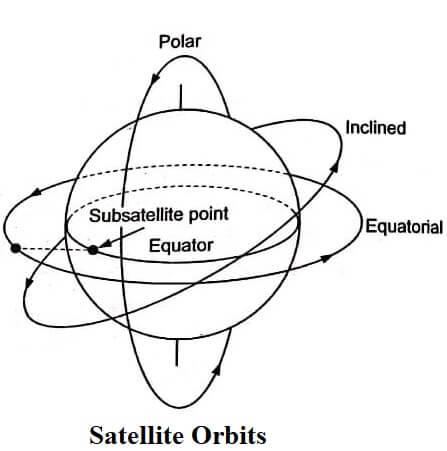The orbits of satellite can be rotated around the earth through various paths. These paths are called orbits of the satellite. These orbits are used to cover the specific application areas.
Orbits of Satellite

When the satellite is moving in the orbits, it stays in position because the centripetal force on the satellite balances the gravitational attractive force of the earth. This balance depends on the distance from the earth, the speed of the satellite, earth’s radius and gravitational force of the earth. The orbit of the satellite is selected on the basis of coverage area required, transmission path loss, delay time and the period for which satellite is visible from the point on the earth. The orbits of the satellite are discussed here.
Inclined Orbit
An inclined orbit is used to cover the polar regions. It is not that frequently used. The height of the inclined orbit is set such that it covers the required area of the region of interest. The time for which the satellite is visible to the point on the earth is also controlled. Satellite cannot remain in continuous contact with the point on the earth if rotating in inclined orbit. Sometimes the inclined orbit is also called elliptical inclined orbit.
Polar Orbit
The Polar orbit shown in fig is not much suitable for communication purposes. It is used for special applications like navigational satellites.
Geostationary Orbit
The circular equatorial orbit is exactly in the plane of equator on the earth. All the points on this orbit are at equal distance from earth’s surface. The satellites rotating in this orbit are mostly used for communication purposes. If the satellite rotating in this orbit has the angular velocity equal to earth’s angular velocity, then the satellite is said to be moving along with the earth. The satellite appears to be stationary to the point on the earth. Therefore this orbit is sometimes called Geostationary orbit. The rotational period of the earth around its axis is 23 hours and 56 minutes. The satellite in the geostationary orbit should complete its rotation around the earth in the same period of 23 hours and 56 minutes. These satellites are therefore called geostationary satellites.
Geosynchronous Orbit
When the inclination of the orbit is not zero and/or eccentricity is not zero, it is called geosynchronous orbit. The period of geosynchronous orbit is equal to period of revolution of earth with itself. This means geostationary orbit and geosynchronous orbit have same period. The similarities and differences between geostationary orbit and geosynchronous orbit are mentioned below :
Table Differences and similarities between geostationary and geosynchronous orbit
| Geostationary orbit | Geosynchronous orbit |
| This orbit is circular. | This orbit is not circular. |
| This orbit lies in equatorial plane, its inclination is zero. | This orbit is inclined with respect to equatorial plane. |
| A satellite in this orbit appears to be stationary with respect to earth. | A satellite in this orbit appears to oscillate with respect to a point on earth. |
| Period of satellite in this orbit is 23 Hr, 56 min and 4.1 sec. | Period of satellite in this orbit is 23 Hr, 56 min and 4.1 sec. |
| There is only one geostationary orbit. | There can be many geosynchronous orbits. |
Geosynchronous satellites are called near geostationary satellites. Exact geostationary orbit cannot be attained in practice. Hence the term geosynchronous satellite is used instead of geostationary satellite.
Orbit Paths
The orbit path itself can be circular or elliptical as shown in Fig.

For circular path, the height of satellite is the distance of satellite from earth but for calculation purpose the height is distance between center of earth and satellite is taken.
Elliptical orbits inclined at an angle of 64° with respect to equatorial plane. For elliptical path, center of earth is one of the focal point of ellipse. Hence the distance between earth and satellite varies during its revolution. The point in the orbit where the satellite is closest to the earth is called the perigee and the point where the satellite is farthest from Apogee the earth is called the apogee. The perigee and apogee distances are measured from the center of the earth’s gravitation force. Therefore apogee and perigee include the radius of earth.

The elliptical orbit of satellite is shown in Fig. where the lengths a and b are the semi major and semi minor axis.
At apogee the satellite is at highest point. Therefore gives the greatest earth coverage region.
| Read More Topics |
| Space division multiple access |
| Multiple access techniques |
| Satellite communication system |





